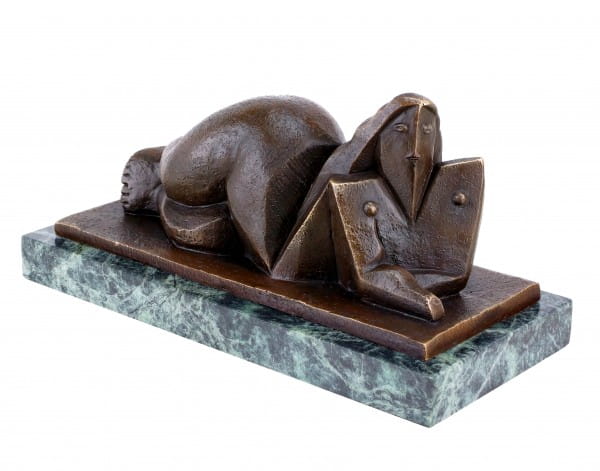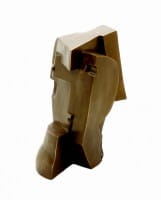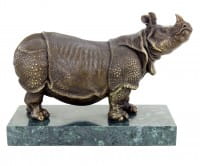Prices incl. VAT, free shipping worldwide
Ready to ship today,
Delivery time appr. 3-6 workdays










Product description
"Jacques Lipchitz - Cubism Sculpture - Signed"
| Height | 17 cm |
| Width | 32 cm |
| Length | 14 cm |
| Weight | 6,1 kg |
Reclining Abstraction – A Cubistic Nude Bronze Inspired - Signed Jacques Lipchitz
This striking Abstract Sculpture reimagines the reclining female body not as a literal representation, but as an exploration of shape, weight, and movement. Angular planes intersect with softened curves, dissolving the traditional figure into a composition of geometric energy. The reduced facial expression becomes a universal symbol rather than a singular identity, encouraging emotion through suggestion rather than detail. In this piece, the viewer is invited to see the body anew, divided into structural elements that harmonize into a powerful presence. Each contour challenges perception, urging reflection on how form and space interact when freed from naturalistic constraints. The work captures the essence of Cubist Portraits, where reality and imagination coexist in bold equilibrium.
The Vision of a Modern Master
The conceptual foundation of this sculpture echoes the influence of Jacques Lipchitz Artist, one of the most groundbreaking sculptors aligned with the Cubist movement. Born Chaim Jakoff Lipschitz on August 22, 1891, in Druskininkai, he moved to Paris in 1909, where he joined the avant-garde community that included Pablo Picasso, Juan Gris, and Amedeo Modigliani. Educated at the École des Beaux-Arts and Académie Julian, he became a leading voice of Jacques Lipchitz Cubism, translating painterly theories into three-dimensional innovation. His sculptures often celebrated rhythmic structure and emphasized emotional abstraction, pushing beyond the limitations of traditional figural work. Forced to flee Europe during World War II because of his Jewish heritage, he later continued his artistic journey in the United States, gaining international recognition for a new sculptural language. Even today, museums honor his legacy by displaying works that shifted the understanding of modern sculpture.
Geometry as Emotional Narrative
Through sharp lines and fragmented surfaces, this reclining figure expresses strength as much as repose. The torso emerges like a shield, suggesting resilience beneath vulnerability. The head and limbs are stylized into bold shapes, revealing how Cubist Portraits can convey inner power through external abstraction. Negative space becomes just as important as mass, allowing light to carve its own patterns into the bronze and constantly reshape the visual experience. From each angle, new relationships appear: curves adjacent to corners, heaviness balanced by levity, intimacy combined with monumentality. This dynamic interplay reflects the sculptural ideals championed by Jacques Lipchitz Artist, making the viewer an active participant in interpretation.
Bronze with Texture and Depth
Cast in bronze, the surface retains the textured vitality of the sculptor’s hand and tools. The material’s natural warmth softens the angularity, giving the figure both human invitation and architectural stability. Highlights shimmer across the abstract planes, while deeper tones settle into crevices, amplifying dimensional contrast. The sculpture’s heaviness conveys permanence, reflecting Lipchitz’s belief that the physicality of Abstract Sculpture should embody the enduring essence of its subject. Resting firmly on a polished marble base, the work claims space with confidence and creates a visual foundation for contemplation. Through its tactile presence, the sculpture transcends representation and becomes a sculptural idea made tangible.
A Dialogue Between Tradition and Innovation
Although defiantly modern, the reclining pose acknowledges classical themes of rest and sensuality, yet displays them through the lens of modernist experiment. The figure appears both grounded and abstracted, stripped of extraneous detail yet enriched through structural complexity. This balance between radical form and recognizable motif reflects the evolution of Jacques Lipchitz Cubism, where the human figure remained central even as it underwent transformation. The sculpture becomes a statement of intellectual curiosity—a refusal to accept reality as static or confined. Viewers are encouraged to question, deconstruct, and rediscover what defines beauty in contemporary creation.
A Collector’s Piece of Deep Cultural Roots
Works inspired by Lipchitz’s aesthetic can be found in significant international collections, including museums in Paris, New York, Jerusalem, and Amsterdam. They continue to resonate with audiences seeking authenticity, innovation, and historical connection. This bronze reclining figure celebrates the power of the abstract to convey human experience with intensity and nuance. Whether displayed in an elegant home, a gallery refined by modern influences, or a curated space dedicated to 20th-century movements, it becomes an anchor of visual exploration. It stands as a reminder that the human form, when seen through new sculptural interpretation, can inspire emotional response and intellectual wonder without relying on realism.
Our advantages
free shipping
Worldwide free shipping
14 days money back
You can cancel your order
within 14 days
secure payment services
Paypal, Master Card, Visa, American Express and more































































